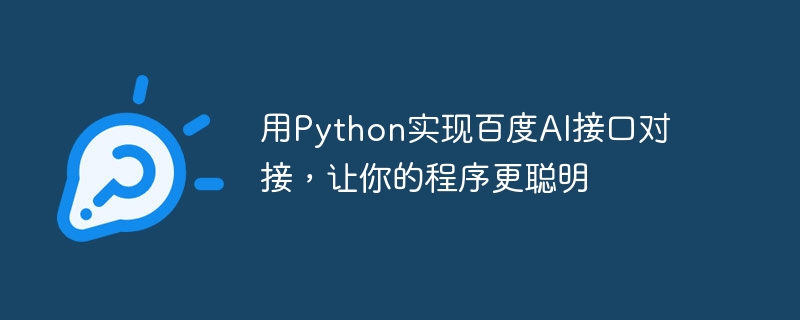Home >Backend Development >Python Tutorial >Use Python to implement Baidu AI interface docking to make your program smarter
Use Python to implement Baidu AI interface docking to make your program smarter
- WBOYWBOYWBOYWBOYWBOYWBOYWBOYWBOYWBOYWBOYWBOYWBOYWBOriginal
- 2023-08-12 21:15:311410browse

Use Python to implement Baidu AI interface docking to make your program smarter
Baidu AI interface provides a wealth of artificial intelligence services, including image recognition, text recognition, Voice recognition and other functions. By connecting these interfaces, we can make our programs more intelligent. This article will use Python as an example to introduce how to use Baidu AI interface to implement some common functions.
First, we need to register an account on Baidu AI open platform and create an application. When creating an application, we must pay attention to obtaining our API Key and Secret Key, which will be used in subsequent code.
1. Image recognition
The image recognition function of Baidu AI interface can identify objects, scenes, text and other information in pictures. The following is a sample code using the image recognition interface:
import requests
import base64
# 获取API Key和Secret Key
API_KEY = 'your_api_key'
SECRET_KEY = 'your_secret_key'
# 图像识别接口
def image_recognition(image_path):
# 读取图片
with open(image_path, 'rb') as f:
image = base64.b64encode(f.read()).decode('utf-8')
# 构造请求参数
params = {
'image': image,
'access_token': get_access_token()
}
# 发送请求
response = requests.post('https://aip.baidubce.com/rest/2.0/image-classify/v2/advanced_general', data=params)
# 解析响应结果
result = response.json()
if 'error_code' in result:
print('Error: {}'.format(result['error_msg']))
else:
for item in result['result']:
print('识别结果:{}'.format(item['keyword']))
# 获取访问令牌
def get_access_token():
# 构造请求参数
params = {
'grant_type': 'client_credentials',
'client_id': API_KEY,
'client_secret': SECRET_KEY
}
# 发送请求
response = requests.post('https://aip.baidubce.com/oauth/2.0/token', data=params)
# 解析响应结果
result = response.json()
return result['access_token']
# 测试
image_recognition('test.jpg')In the above code, we first define a image_recognition function, which receives an image path as an input parameter. Inside the function, we first read the image and convert it into a Base64 encoded string. Then, we constructed a dictionary containing parameters such as pictures and access tokens, and sent a Post request to the image recognition interface. The result returned by the interface is a JSON object containing the recognition results, which we can extract and print to view the recognition results.
In addition, we also define a get_access_token function to obtain the access token. This function sends a request to the API server, obtains the access token, and returns it.
2. Text recognition
The text recognition function of Baidu AI interface can identify text information in pictures. Here is a sample code using the text recognition interface:
import requests
import base64
# 获取API Key和Secret Key
API_KEY = 'your_api_key'
SECRET_KEY = 'your_secret_key'
# 文字识别接口
def ocr(image_path):
# 读取图片
with open(image_path, 'rb') as f:
image = base64.b64encode(f.read()).decode('utf-8')
# 构造请求参数
params = {
'image': image,
'access_token': get_access_token()
}
# 发送请求
response = requests.post('https://aip.baidubce.com/rest/2.0/ocr/v1/general_basic', data=params)
# 解析响应结果
result = response.json()
if 'error_code' in result:
print('Error: {}'.format(result['error_msg']))
else:
for item in result['words_result']:
print('识别结果:{}'.format(item['words']))
# 获取访问令牌
def get_access_token():
# 构造请求参数
par
...The above is the detailed content of Use Python to implement Baidu AI interface docking to make your program smarter. For more information, please follow other related articles on the PHP Chinese website!
Related articles
See more- Use PHP and Baidu AI to review text and images
- What is the usage of range function in python
- Learn Python to implement Qiniu Cloud interface docking and image filter synthesis
- A basic introductory guide to connecting Python with Baidu AI interface
- Common problems and solutions for connecting Java to Baidu AI interface

